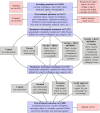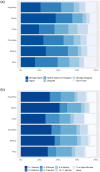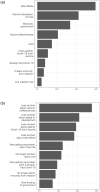Messages that increase COVID-19 vaccine acceptance: Evidence from online experiments in six Latin American countries
- PMID: 34710168
- PMCID: PMC8553119
- DOI: 10.1371/journal.pone.0259059
Messages that increase COVID-19 vaccine acceptance: Evidence from online experiments in six Latin American countries
Abstract
As safe and effective vaccines become widely available, attaining herd immunity and limiting the spread of COVID-19 will depend on individuals choosing to vaccinate-and doing so quickly enough to outpace mutations. Using online surveys conducted across six Latin American countries in January 2021, we experimentally assess messages designed to counteract informational deficiencies and collective action problems that may drive hesitancy. We first find that basic vaccine information persuades around 8% of hesitant individuals to become willing to vaccinate, reduces intended wait to vaccinate by 0.4 months, and increases willingness to encourage others to vaccinate. Rather than facilitating free riding, learning, or social conformity, additional information about others' behavior increases vaccine acceptance when respondents expect herd immunity will be achieved. Finally, priming the social approval benefits of vaccinating also increases vaccine acceptance. These results suggest that providing information and shaping social expectations and incentives could both significantly increase vaccine uptake.
Conflict of interest statement
The authors have declared that no competing interests exist.
Figures







Similar articles
-
High but slightly declining COVID-19 vaccine acceptance and reasons for vaccine acceptance, Finland April to December 2020.Epidemiol Infect. 2021 May 11;149:e123. doi: 10.1017/S0950268821001114. Epidemiol Infect. 2021. PMID: 33972001 Free PMC article.
-
Assessment of Communication Strategies for Mitigating COVID-19 Vaccine-Specific Hesitancy in Canada.JAMA Netw Open. 2021 Sep 1;4(9):e2126635. doi: 10.1001/jamanetworkopen.2021.26635. JAMA Netw Open. 2021. PMID: 34591105 Free PMC article.
-
Medical experimentation and the roots of COVID-19 vaccine hesitancy among Indigenous Peoples in Canada.CMAJ. 2021 Mar 15;193(11):E381-E383. doi: 10.1503/cmaj.210112. Epub 2021 Feb 24. CMAJ. 2021. PMID: 33627413 Free PMC article. No abstract available.
-
COVID-19 vaccine hesitancy in South Africa: how can we maximize uptake of COVID-19 vaccines?Expert Rev Vaccines. 2021 Aug;20(8):921-933. doi: 10.1080/14760584.2021.1949291. Epub 2021 Jul 12. Expert Rev Vaccines. 2021. PMID: 34252336 Review.
-
Will vaccination refusal prolong the war on SARS-CoV-2?Postgrad Med J. 2021 Mar;97(1145):143-149. doi: 10.1136/postgradmedj-2020-138903. Epub 2020 Oct 28. Postgrad Med J. 2021. PMID: 33115909 Free PMC article. Review.
Cited by
-
Priming congruence and COVID-19 vaccination intention: a mediation analysis.Health Psychol Rep. 2023 Mar 21;12(1):79-86. doi: 10.5114/hpr/157228. eCollection 2024. Health Psychol Rep. 2023. PMID: 38425890 Free PMC article.
-
Public response to government alerts saves lives during Russian invasion of Ukraine.Proc Natl Acad Sci U S A. 2023 May 2;120(18):e2220160120. doi: 10.1073/pnas.2220160120. Epub 2023 Apr 24. Proc Natl Acad Sci U S A. 2023. PMID: 37094165 Free PMC article.
-
COVID-19 Vaccine Motivation and Hesitancy among a Sample of African American, Afro-Caribbean, and African Respondents in the United States.Vaccines (Basel). 2024 May 24;12(6):571. doi: 10.3390/vaccines12060571. Vaccines (Basel). 2024. PMID: 38932300 Free PMC article.
-
Drivers of the Intention to Receive a COVID-19 Booster Vaccine: Insights from the UK and Australia.Vaccines (Basel). 2022 Oct 17;10(10):1730. doi: 10.3390/vaccines10101730. Vaccines (Basel). 2022. PMID: 36298595 Free PMC article.
-
The links between COVID-19 vaccine acceptance and non-pharmaceutical interventions.Soc Sci Med. 2023 Mar;320:115682. doi: 10.1016/j.socscimed.2023.115682. Epub 2023 Jan 14. Soc Sci Med. 2023. PMID: 36709691 Free PMC article.
References
-
- Ipsos. COVID-19 vaccination intent has soared across the world. 2021. www.ipsos.com/en/covid-19-vaccination-intent-has-soared-across-world.
Publication types
MeSH terms
Substances
LinkOut - more resources
Full Text Sources
Medical
Research Materials

